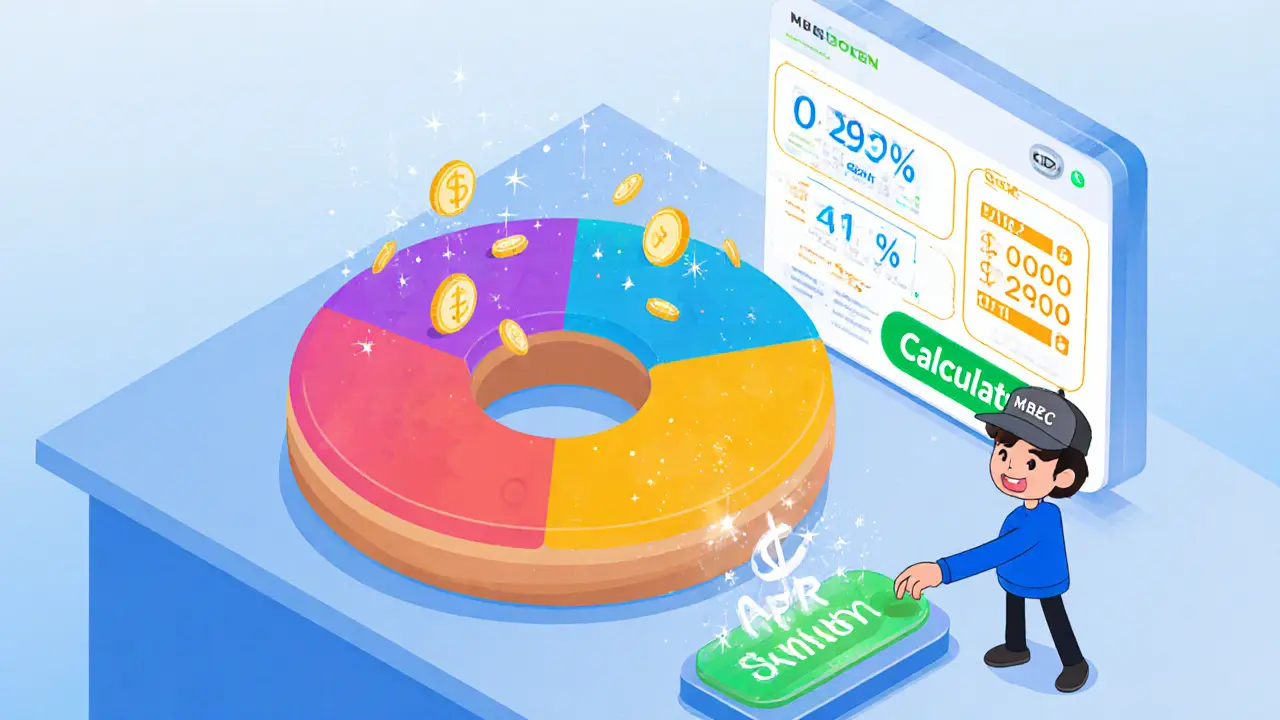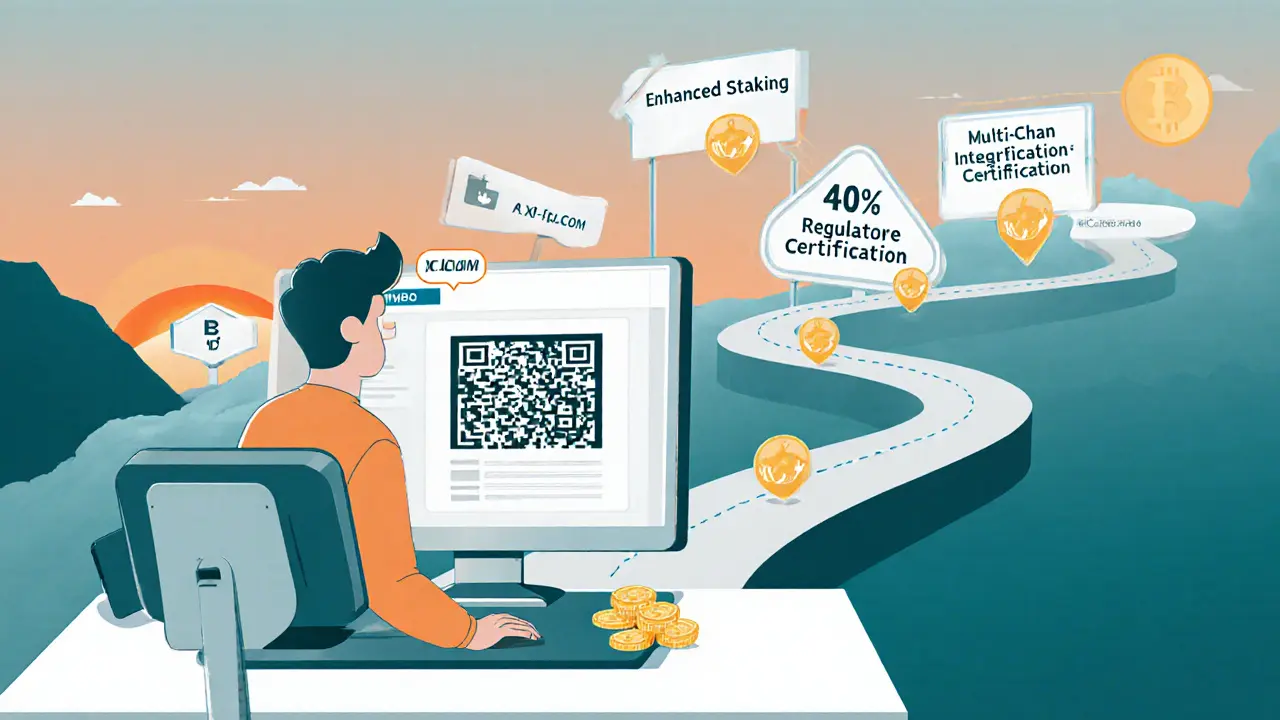MonbaseCoin (MBC) Calculator
Staking Returns Calculator
Token Value Estimator
Tokenomics Overview
Key Uses of MBC
- Fee Discounts 30%
- Staking Rewards Variable
- Governance Voting One Vote per MBC
- Launchpad Participation Preferential Access
- Ecosystem Payments Premium Services
Quick facts about MonbaseCoin (MBC)
- Native utility token of the Monbase exchange ecosystem.
- Current price (Oct2025): ~MonbaseCoin $0.30 USD (prices vary across trackers).
- Max supply: 200million MBC; circulating supply ~189.7million.
- Primary trading pair: MBC/USDT on XT.COM (≈99.9% of volume).
- Key uses: fee discounts, staking rewards, governance voting, Launchpad participation.
If you’ve seen the ticker MBC popping up on a crypto chart and wondered what it actually does, you’re in the right spot. Below we break down MonbaseCoin, its role, where you can get it, and what risks you should keep an eye on.
What is MonbaseCoin?
MonbaseCoin is the native utility cryptocurrency that powers the Monbase exchange ecosystem. The token serves both as a medium of exchange for lower‑fee trades and as a governance instrument that lets holders vote on platform upgrades, token‑sale listings, and other strategic decisions.
Current market snapshot
Price data differ wildly depending on the source. CoinMarketCap lists MBC at $0.3001 with a 24‑h volume of about $99,900. Meanwhile, Binance (via its API) reported $0.6299, and CoinGecko showed $0.1794. This spread signals thin liquidity and a fragmented order book.
The lion’s share of trading happens on XT.COM, where the MBC/USDT pair captures 99.92% of total volume and trades with a 1.54% spread. Smaller trades appear on the native Monbase portal, but those volumes are negligible compared with XT.COM.
Tokenomics at a glance
MonbaseCoin’s supply is capped at 200million tokens. According to Holder.io, about 189.7million are already in circulation - roughly 95% of the total. The remaining 10.3million are reserved for future ecosystem incentives, team vesting, and strategic partnerships.
The market cap fluctuates with price: when MBC trades near $0.30, the cap sits around $58million (Holder.io). If you use the higher Binance price, the cap jumps above $125million, illustrating how volatile the valuation can be.

How MBC is used inside the Monbase ecosystem
- Fee discounts: Holding MBC reduces spot‑trading fees by up to 30% on the Monbase platform.
- Staking rewards: Users can lock MBC in a staking pool and earn additional MBC or other project tokens, depending on the current reward schedule.
- Governance voting: Each MBC gives one vote on proposals ranging from new token listings to changes in the fee‑rebate structure.
- Launchpad and Launchpool participation: MBC holders get preferential access to early‑stage token sales and higher allocation limits.
- Ecosystem fee payments: Certain premium services-like advanced charting, margin trading, or copy‑trading-require payment in MBC.
The token’s utility model aims to create a self‑reinforcing loop: more users need MBC to reduce fees, which drives demand, which in turn should lift price-assuming the exchange gains traction.
How MonbaseCoin stacks up against other exchange tokens
| Token | Max Supply | Current Price (USD) | 24‑h Volume | Primary Exchange(s) |
|---|---|---|---|---|
| MonbaseCoin (MBC) | 200M | 0.30 (average) | $100k (XT.COM) | XT.COM, Monbase portal |
| Binance Coin (BNB) | 200M | 420 | $3.2B (Binance) | Binance, many others |
| KuCoin Token (KCS) | 200M | 12.5 | $400M (KuCoin) | KuCoin, select CEXs |
| FTT (FTX Token) | 1B | 1.8 | $150M (various) | Limited after FTX collapse |
Compared with heavyweights like BNB, MBC is a tiny player. Its market cap is in the low tens of millions versus BNB’s multi‑billion valuation. The most glaring gap is liquidity-BNB trades billions daily on dozens of platforms, while MBC’s activity is confined mostly to XT.COM.
Risks and criticisms
- Liquidity crunch: With the bulk of volume on a single exchange, price swings can be abrupt. A relatively small order can move the price by several percent.
- Limited exchange listings: MBC is absent from major hubs like Binance, Coinbase, or Kraken, restricting access for mainstream traders.
- Regulatory exposure: Centralized exchange tokens often draw scrutiny. If Monbase fails to obtain compliance certifications, the token could be delisted or even frozen.
- Speculative price dynamics: Recent data shows a 644% one‑year gain, but that is driven by hype rather than fundamentals. Future price could easily reverse.
- Community size: Social media following and forum activity are modest, meaning less organic promotion and fewer third‑party tools.
All those points suggest that MBC is best suited for risk‑tolerant early adopters who believe in Monbase’s long‑term roadmap.
How to buy and store MonbaseCoin
- Register on XT.COM. Complete KYC if you want higher withdrawal limits.
- Deposit a stablecoin (USDT preferred) into your XT.COM wallet.
- Navigate to the MBC/USDT market and place a market or limit order.
- Withdraw the purchased MBC to a supported wallet. Currently, the official Monbase mobile app and most hardware wallets (Ledger, Trezor) can store the BEP‑20 version of MBC.
- If you plan to stake, use the staking tab on the Monbase portal; the platform will lock your tokens and start accruing rewards automatically.
The process is straightforward but beware of withdrawal fees on XT.COM (typically 0.1% of the transaction) and the possibility of network congestion on the underlying blockchain.
Future outlook and roadmap
Monbase launched version01 on 26Mar2024, promising a suite of spot, margin, futures, P2P, and copy‑trading features. The roadmap lists three major milestones for 2025‑2026:
- Enhanced staking mechanisms with variable APR based on platform revenue.
- Integration of additional blockchain networks (e.g., Polygon, Solana) to broaden token listings.
- Regulatory compliance certifications for Europe and Australia, aiming to attract institutional users.
Analyst reports from Digital Coin Price are bullish-projecting a $5‑plus price by 2032-but those forecasts lack solid fundamentals. Realistically, MBC’s upside hinges on Monbase attracting a sizable user base, expanding listings beyond XT.COM, and surviving regulatory headwinds.

Frequently Asked Questions
What is the primary use case for MonbaseCoin?
MBC is mainly used to reduce trading fees on the Monbase exchange, to stake for additional rewards, and to vote on governance proposals such as new token listings or fee‑rebate changes.
Where can I buy MBC?
The most liquid market is the MBC/USDT pair on XT.COM. You can also purchase it directly through the Monbase portal if you already have an account there, though liquidity is far lower.
Is MonbaseCoin a good long‑term investment?
It’s high‑risk. Potential upside exists if Monbase grows its user base and secures regulatory approval, but the token’s thin liquidity, limited exchange listings, and price volatility make it a speculative play.
How does staking work for MBC?
Stake MBC on the Monbase platform by locking your tokens in the staking dashboard. Rewards are distributed weekly and can be paid in MBC or partner tokens, depending on the active pool’s configuration.
What are the main risks of holding MBC?
Key risks include low liquidity (price can swing wildly), limited exchange availability, regulatory uncertainty for the underlying exchange, and the possibility of the token losing value if Monbase fails to attract users.
In short, MonbaseCoin offers typical exchange‑token perks-cheaper trades, staking, and voting-but it’s still a niche asset confined to a small ecosystem. Treat it like any early‑stage crypto: only invest what you can afford to lose and stay updated on platform developments.


It feels like they’re hiding a massive pump‑and‑dump behind that glossy MBC brochure.
All right, folks, let’s break this down. MBC’s fee‑discount model is standard for exchange tokens, but the real kicker is staking. If you lock your coins, you could earn a decent slice of the platform’s revenue, assuming Monbase actually grows. Keep an eye on the APR – it can swing wildly.
Reading through the tokenomics, I noticed the circulating supply is already 95% of the max, which means there isn’t much room for future inflation. That’s a plus for price stability, but it also signals the team has already pumped most of the coins into the market. For a newcomer, the biggest risk is the thin liquidity on XT.COM, which can cause price spikes on modest trades.
From a structural standpoint, MBC exemplifies the classic exchange‑native token archetype, yet it suffers from a paucity of cross‑exchange arbitrage opportunities, which inherently limits price discovery. The token’s utility framework-fee discounts, staking rewards, governance voting, launchpad access-creates a circular demand loop, but that loop is contingent upon user adoption, which is presently nascent. Moreover, the concentration of 99.9% of volume on XT.COM introduces a single‑point‑of‑failure scenario; any operational disruption could precipitate a liquidity vacuum. The reported price disparity-from $0.18 on CoinGecko to $0.63 on Binance-highlights fragmented order books and potential market manipulation. In terms of tokenomics, a 200 million max supply with 189.7 million circulating translates to a supply‑dilution factor of merely 5%, rendering future inflationary pressures minimal. However, the reserved 10.3 million tokens earmarked for ecosystem incentives could be released in tranches, diluting value if not capped by commensurate demand. The governance model grants one vote per MBC, which theoretically democratizes platform decisions but may also enable whale dominance if large holders align. Staking rewards are described as “variable,” a vague term that obscures the expected yield and could be adjusted downward during bearish cycles. The roadmap’s emphasis on multi‑chain integration is ambitious, yet execution risk remains high given the current limited developer resources. Regulatory exposure is another vector; centralized exchanges with native tokens have attracted scrutiny from authorities in multiple jurisdictions. Should Monbase fail to secure requisite licenses, the token could be delisted from even marginal venues, eroding liquidity further. The market cap oscillates dramatically based on the source price, ranging from $58 million to over $125 million, which underscores volatility. From a technical perspective, the token operates on the BEP‑20 standard, enabling storage on popular hardware wallets, but the ecosystem lacks robust DeFi integrations. Community engagement appears modest, with limited social media traction, which diminishes organic marketing. In essence, MBC presents a textbook case of high‑risk, high‑potential speculative assets, where upside is tightly coupled to user growth and regulatory clearance.
Sounds like a classic “early‑adopter” play-fun if you can handle the swings.
Wow!!! This analysis is *overkill*-you’ve managed to cram every possible red flag into one paragraph!!!! But seriously, the fact that you wrote *so* much shows just how shaky the foundation is; the token’s utility is basically a vanity feature, and the liquidity trap you mentioned is a deal‑breaker for anyone looking to actually trade.
The data points you’ve highlighted just reinforce the fundamental flaw: MBC is a textbook example of a token that exists solely to inflate the exchange’s fee‑rebate narrative. The tokenomics sheet reads like a marketing brochure, with buzzwords but no substantive backing. You’ll see that the “reserved supply” is a vague catch‑all for future token dumps, a classic tactic to keep the price buoyant in the short term. The APR figures are not locked; they’re subject to the platform’s profitability, which is unproven. Moreover, the heavy reliance on a single market (XT.COM) creates an artificial price floor that disappears once volume dries up. The spread discrepancies across trackers betray a lack of arbitrage mechanisms, making price discovery unreliable. In short, unless Monbase can secure listings on major exchanges, MBC will remain a niche, high‑risk asset. Investors would be wiser to allocate capital elsewhere.
Exactly, the whole thing is a sham-stay away.
For anyone considering MBC, it’s worth noting that the staking dashboard on the Monbase portal provides weekly reward statements, which can help you track actual yields versus advertised APR. Also, keep an eye on withdrawal fees; they can erode profits, especially on smaller positions. Lastly, monitor the token’s listing status-if it ever appears on a larger exchange, liquidity could improve significantly.
Thanks for the info,, I’ll definitely check the weekly statements,,, but... I’m still not sure about the withdrawal fee structure,,, is it a flat rate or % based??!!
One might posit that the ontological status of MBC is intrinsically linked to the collective belief of its holders; absent that belief, the token’s existence is purely symbolic. Consequently, its valuation is a reflection of communal perception rather than intrinsic utility.
Oh great, another “groundbreaking” token that promises fee discounts and governance power-because the crypto world clearly needed more ways to feel important while paying less to trade. The promised 30% discount is adorable, almost as adorable as the notion that a handful of tokens can actually influence exchange policy. And let’s not forget the staking rewards, which are “variable”-a euphemism for “maybe you’ll get something, maybe you won’t.” The roadmap claims multi‑chain integration, but given the current thin liquidity, that sounds like dreaming while driving a tricycle. Regulatory scrutiny? Yeah, you’re right, walking a tightrope while juggling flaming torches. Bottom line: if you enjoy speculative roller‑coasters, MBC might be your cup of tea.
MBC offers typical exchange‑token benefits, but its real value hinges on Monbase’s ability to grow its user base. The fee‑discount mechanism can be attractive for frequent traders, yet the limited market exposure caps its upside. Staking provides an additional incentive, though the exact APR is subject to change. Overall, treat it as a speculative asset with moderate risk.
I agree with the balanced view-if Monbase can broaden its listings beyond XT.COM, the token’s utility could become more compelling. Diversifying the ecosystem would also mitigate the liquidity risk that many of us worry about. Until then, a cautious allocation seems prudent.
It’s disheartening to see so many users idolize a token that offers nothing more than a modest fee discount. The moral responsibility of investors is to demand transparency, yet the community seems content with vague promises and surface‑level incentives. When a project latches onto the “exchange token” hype without delivering substantial innovation, it’s a betrayal of the crypto ethos. We should be holding these platforms accountable, not blindly celebrating every new ticker. Real progress comes from building real value, not from sprinkling tokenomics buzzwords over a thinly traded asset.
In conclusion, MBC’s prospects depend on user adoption and regulatory compliance. Investors should conduct thorough due diligence before allocating capital.